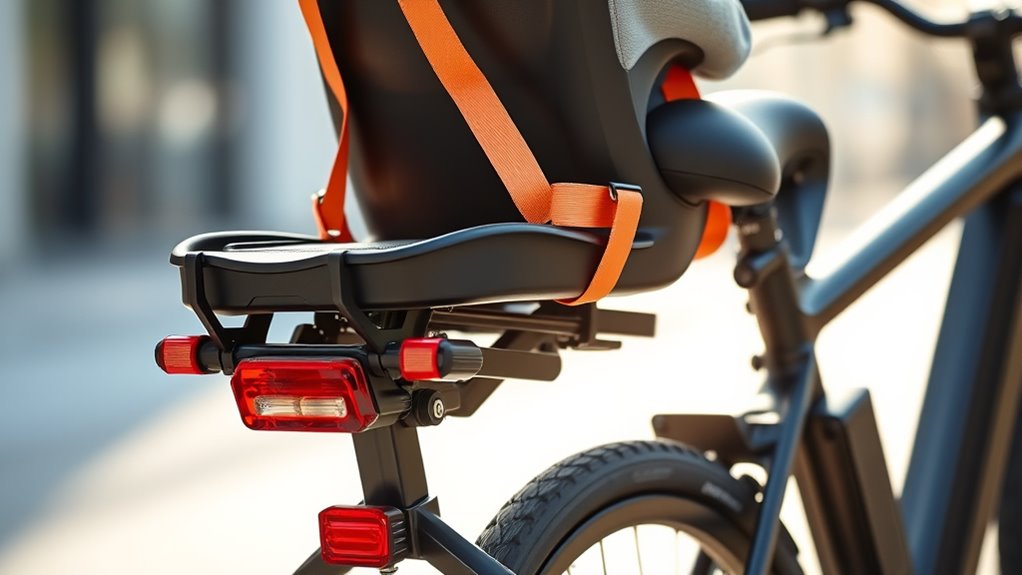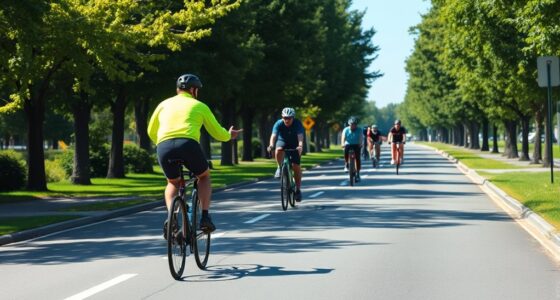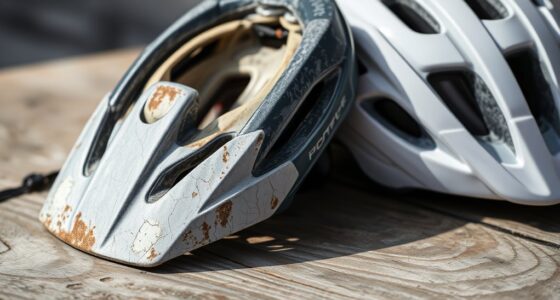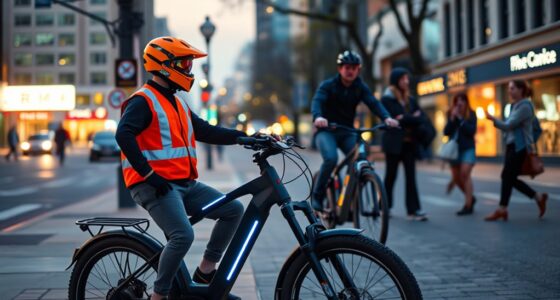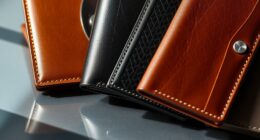To fit a child seat on your e-bike, start by choosing a sturdy seat designed for bike frames, ensuring it supports your child’s weight and fits your bike’s mounting points. Attach the seat securely to a rear rack or frame support using the appropriate brackets and tools, tightening bolts evenly. Adjust the seat and harness for comfort and safety, then check stability and security. For detailed step-by-step guidance, continue exploring the best ways to keep your little one safe on the road.
Key Takeaways
- Choose a sturdy, appropriately sized child seat with safety features and reflective elements for visibility.
- Verify your e-bike has compatible mounting points or racks designed for child seats.
- Securely attach the seat to the frame using correct brackets, bolts, and tools, ensuring proper alignment.
- Adjust the seat and harness for child comfort and safety, ensuring secure straps and footrests.
- Regularly inspect the mounting, safety features, and bolts for stability and wear before each ride.
Choosing the Right Child Seat for Your E-Bike
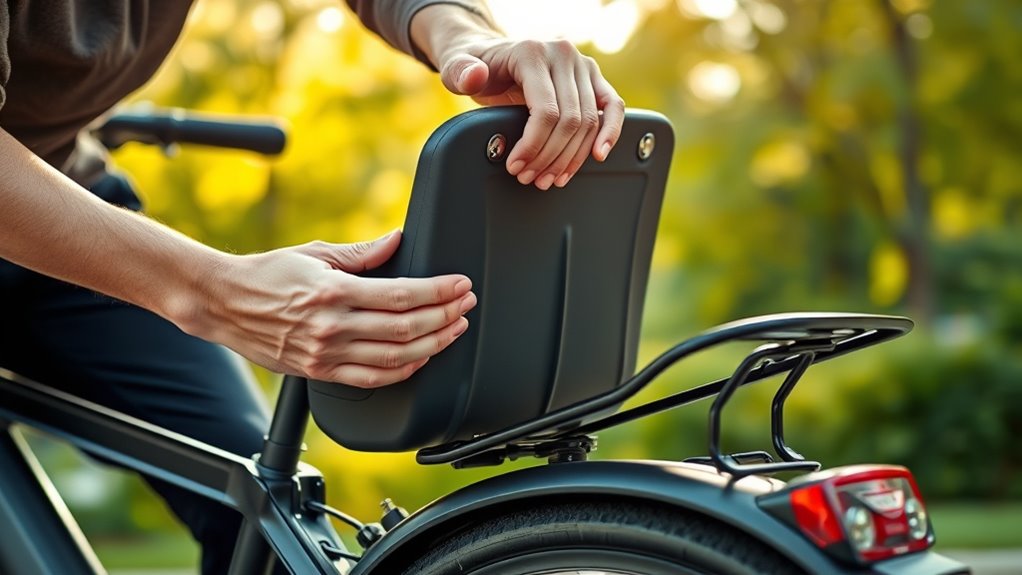
Choosing the right child seat for your e-bike is essential to guarantee your child’s safety and comfort. Start by considering the child seat materials; look for sturdy, durable options like reinforced plastic or metal frames combined with padded cushions for comfort. These materials ensure the seat withstands daily use and provides stability. Next, think about color options—select a bright or reflective color to increase visibility during rides, enhancing safety. Some seats come in vibrant hues or with reflective accents that make your child more noticeable to other road users. Focus on these factors to find a seat that’s both safe and appealing. Remember, a well-chosen child seat made from quality materials and available in suitable colors will make riding enjoyable and secure for both of you. Additionally, checking the installation process for ease and compatibility with your e-bike model can prevent future issues and ensure a secure fit.
Checking Compatibility With Your Bike Model
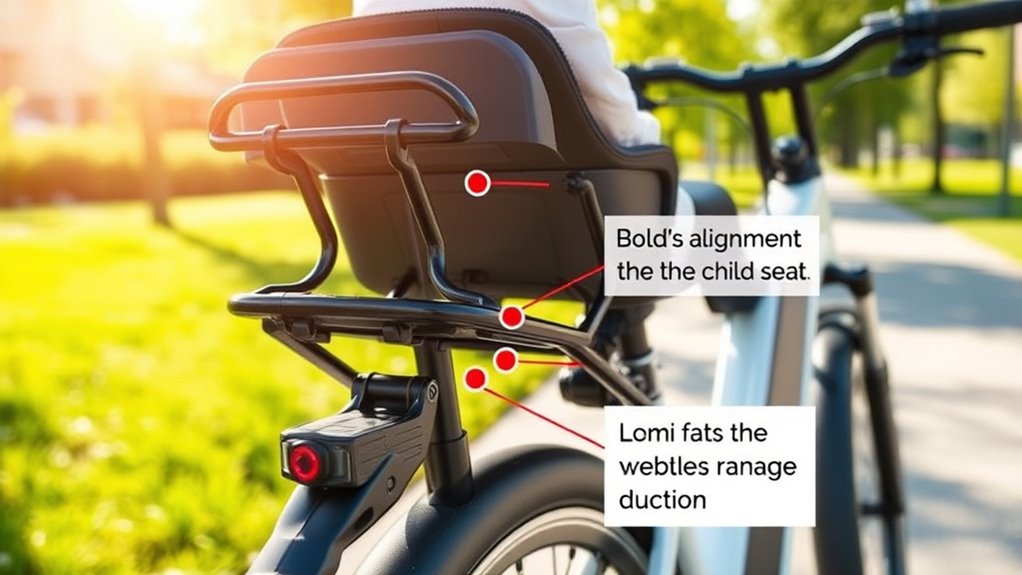
Before installing a child seat, you need to verify if your bike frame can support it. Check your bike’s mounting points and see what options are available for attaching the seat securely. Ensuring compatibility prevents installation issues and keeps your child safe during rides. Additionally, consider the Kia Tuning options that could improve your bike’s handling and stability, making it safer and more comfortable for both rider and child.
Bike Frame Compatibility
Is your e-bike’s frame compatible with a child seat? First, check if your bike has a sturdy mounting point or rack designed for child seats. Some frames, especially step-through or compact models, may lack the necessary attachment points. Also, confirm your tire pressure is properly set, as under- or over-inflated tires can affect stability when carrying extra weight. A well-fitted helmet for your child is essential, but equally important is ensuring your bike’s frame can support the added load safely. Measure the frame’s dimensions and verify compatibility with the seat’s mounting system. If your bike’s frame is incompatible, you might need an adapter or consider a different model. Always prioritize safety and stability before proceeding with installation. Proper frame support is crucial to ensure your child’s safety and the bike’s performance during rides.
Mounting Options Available
Once you’ve confirmed that your bike’s frame can support a child seat, it’s important to explore the mounting options available for your specific model. Different bikes offer various attachment points, such as rear racks, frame mounts, or specialized quick-release systems. Consider how each option affects child seat comfort—look for stable, secure mounts that minimize vibrations and wobbling. Weather considerations are also vital; if you often ride in rain or intense sun, choose mounting solutions that provide protection and ease of access for quick detachment or adjustment. Some mounting options may require additional adapters or accessories. Checking compatibility ensures a safe, comfortable ride for your child while accommodating your riding environment. Always prioritize stability and weather resistance to guarantee long-term safety and comfort. Additionally, reviewing community feedback can provide insights into real-world performance and durability of different mounting systems.
Gathering Necessary Tools and Equipment

To securely install a child seat on your e-bike, you’ll need to gather the right tools and equipment beforehand. Making certain child safety starts with proper preparation. Check that you have essential bike accessories like a sturdy mounting bracket and compatible straps. You’ll also need basic tools such as an Allen wrench, screwdriver, and possibly a torque wrench. Additionally, verifying the best anime movies suitable for children can help ensure your child’s entertainment during longer rides. Here’s a quick overview:
| Tool/Equipment | Purpose | Importance for Child Safety |
|---|---|---|
| Allen Wrench | Tightening bolts | Ensures secure attachment |
| Mounting Bracket | Supports child seat | Prevents wobbling or detachment |
| Reflective Tape/Lights | Visibility | Keeps your child safe during rides |
Gather these to ensure a safe, stable, and enjoyable biking experience.
Positioning the Child Seat on the Frame
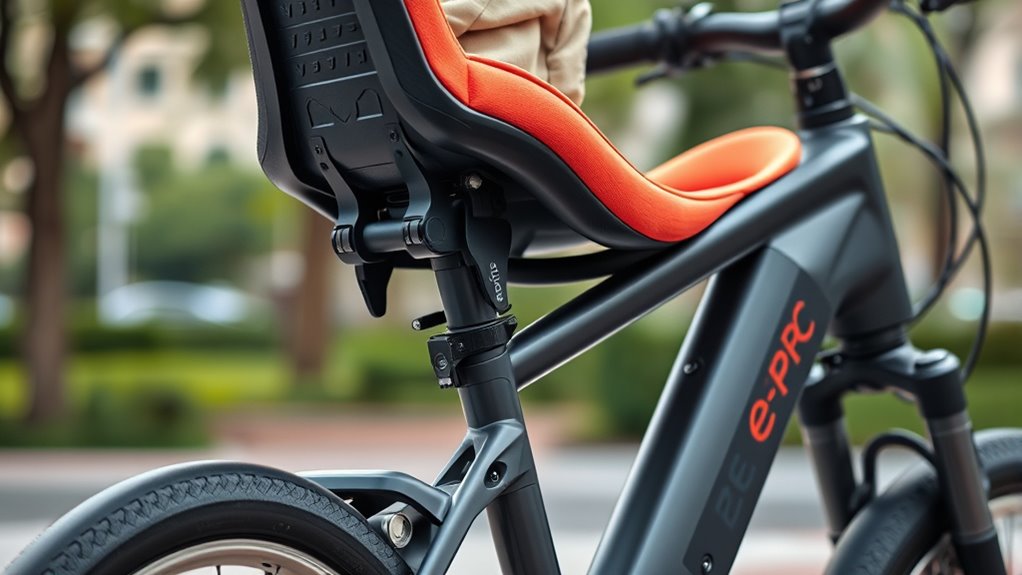
Positioning the child seat correctly on your e-bike’s frame is essential for safety and stability. Start by choosing a suitable frame that supports child seat mounting, such as one with a sturdy rear rack or designated mounting points. When doing child seat positioning, ensure it’s mounted at the appropriate height and distance from the handlebars and pedals, so your child remains balanced and comfortable. Make sure the seat is aligned straight and securely attached to prevent movement during rides. Check for any interference with the rear wheel or brakes. Proper frame selection and thoughtful positioning help maintain your bike’s center of gravity, making riding safer and easier. Additionally, understanding the importance of projector contrast ratio can help you better evaluate the safety and stability of your setup. Take your time to adjust the seat until it’s firmly in place and offers ideal support for your child.
Securing the Mounting Brackets Properly
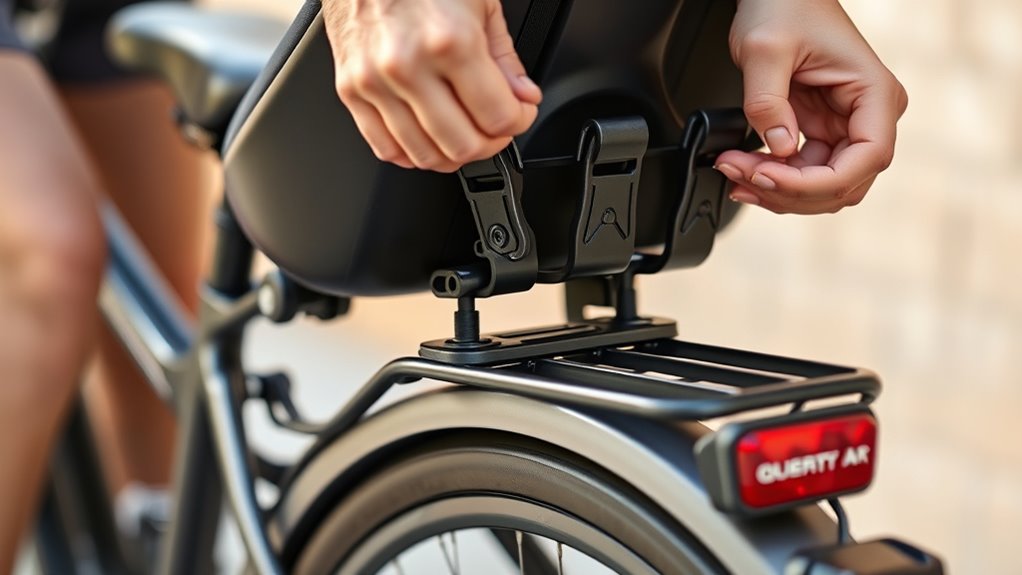
Before riding, make sure the mounting brackets are aligned correctly to prevent any movement. Tighten all bolts securely to keep the child seat stable during your ride. Regularly check the brackets for looseness or shifts to guarantee ongoing safety. Remember, a strong father-daughter bond can inspire confidence in your child’s safety and comfort.
Check Bracket Alignment
Have you double-checked that the mounting brackets are aligned correctly? Proper bracket alignment ensures the child seat stays secure and doesn’t damage your bike’s frame. Start by verifying that the brackets match your bike’s frame compatibility. Misaligned brackets can cause instability or frame damage. To confirm, check the position of each bracket relative to the frame, ensuring they sit flush and parallel. Use this visual guide:
| Frame Compatibility | Bracket Alignment | Result |
|---|---|---|
| Compatible Frame | Properly aligned | Secure and stable fit |
| Slight mismatch | Slight misalignment | Risk of looseness or damage |
| Incompatible Frame | Misaligned | Not suitable or unsafe |
| Frame with curves | Adjust brackets accordingly | Ensure flush contact |
| Straight frame | Keep brackets parallel | Optimal stability |
Aligning brackets correctly is vital for safety and durability. Additionally, consulting the manufacturer’s instructions can further ensure correct installation.
Tighten Bolts Securely
Once you’ve confirmed that the brackets are properly aligned, it’s essential to tighten the bolts securely to guarantee a stable and safe mount. Use your bike’s recommended torque specifications to ensure proper bolt tightening without over-tightening, which could damage the bracket or frame. Apply consistent pressure when tightening each bolt, working in a crisscross pattern if multiple bolts are involved. Double-check that all bolts are snug but not forced, maintaining the integrity of the mount. Proper bolt tightening prevents any movement or loosening during rides, ensuring your child’s safety. Remember, using a torque wrench is the best way to achieve the correct tightness, following manufacturer guidelines precisely. Proper bolt tightening is crucial for the longevity of your bike components and safety during rides. Secure bolts properly, and your child seat will stay firmly in place.
Verify Stability Regularly
Regularly checking the stability of the child seat mount is crucial to guarantee ongoing safety. Over time, vibrations and frequent use can loosen mounting brackets. Confirm the brackets remain tightly secured, especially if your child seat’s materials or ergonomic design have shifted. Regular inspections help identify wear or damage early. Look for any wobbling or creaking that indicates instability. Keep in mind that a secure mount prevents accidents and ensures comfort for your child. Use a torque wrench if needed to confirm bolts stay tight. Also, check that the mounting system suits your child seat’s ergonomic design, providing proper support. Frequent checks help maintain safety standards and protect your little rider during every ride. Proper maintenance reduces the risk of failure and prolongs the lifespan of your child seat components.
Attaching the Child Seat to the E-Bike

Attaching a child seat securely to your e-bike is essential for safety and stability during rides. Start by choosing a seat compatible with your bike’s frame and weight limits. Make sure it’s firmly mounted using the appropriate brackets and bolts, tightening all fasteners properly. Always prioritize helmet safety; ensure your child wears a helmet that fits well and is securely fastened before each ride. Consider weather conditions—if rain or strong wind is expected, double-check that the seat and mounting points can handle the elements without loosening. Secure all straps and harnesses tightly, and verify the seat doesn’t wobble or shift. Proper attachment prevents accidents and keeps your child safe, no matter the weather or ride duration. Additionally, vetted child seats are designed with safety features that meet industry standards, providing extra peace of mind during your outings.
Adjusting the Seat for Child Comfort and Safety
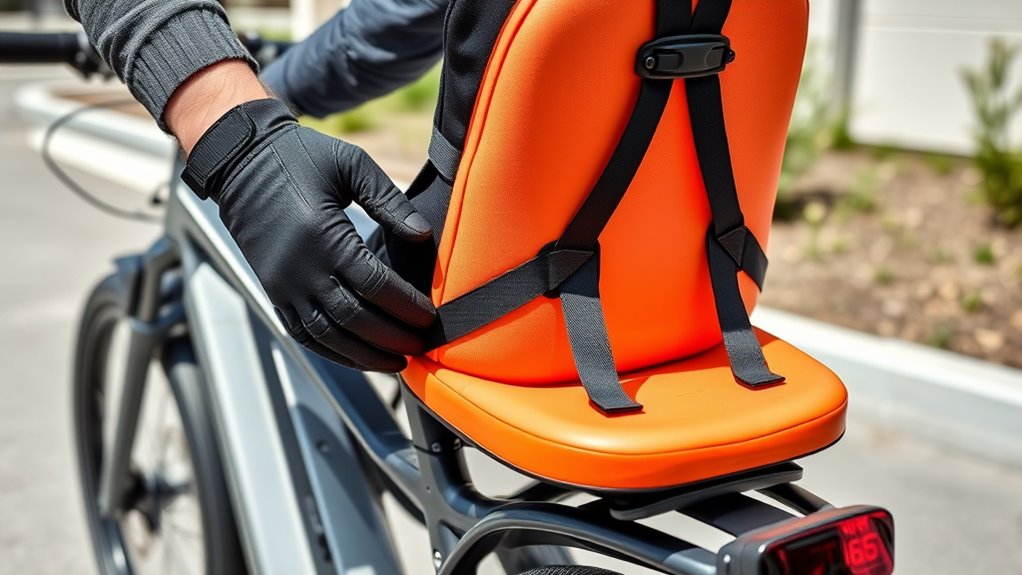
To guarantee your child rides safely and comfortably, you need to properly adjust the child seat before each trip. Focus on the seat’s ergonomic design to ensure your child is supported properly. Check the child seat materials for durability and comfort, making sure they’re soft yet sturdy. Adjust the footrests so your child’s feet are secure but not cramped. Ensure the backrest aligns with their spine and provides enough support. Confirm the seat belt or harness fits snugly without restricting movement. Lastly, verify the seat’s position on the bike for balance and visibility. Proper padding and cushioning help absorb shocks from rough terrain. Additionally, ensure the seat height allows your child’s feet to reach the pedals comfortably and safely. Secure fastening points are crucial to prevent any loosening during rides. Adjustable head support helps protect your child’s neck and head in case of sudden stops. Comfortable, breathable materials prevent excessive sweating and discomfort. Regularly check the seat’s attachment points and harnesses to maintain safety standards. Also, consider the bike’s weight distribution and stability when positioning the child seat, especially for bike stability during turns and stops.
Installing Safety Features and Harnesses

Ensuring safety features and harnesses are properly installed is essential for your child’s protection during rides. Start by selecting a safety harness type suitable for your child’s age and size. Options include five-point, three-point, or lap belts, depending on the seat. Child seat materials matter too; choose durable, padded options for comfort and safety. Confirm the harness is tight enough to secure your child without restricting movement. Use the table below to compare harness types and materials:
| Safety Harness Types | Child Seat Materials | Best Use Case |
|---|---|---|
| Five-point harness | Padded, durable fabric | Toddlers |
| Three-point harness | Breathable, lightweight | Older children |
| Lap belt | Reinforced plastic | Quick trips |
| Shoulder straps | Padded straps | Long rides |
Proper installation guarantees your child’s safety on every ride. Additionally, regularly inspect safety features to ensure they remain secure and in good condition.
Conducting a Stability and Security Check
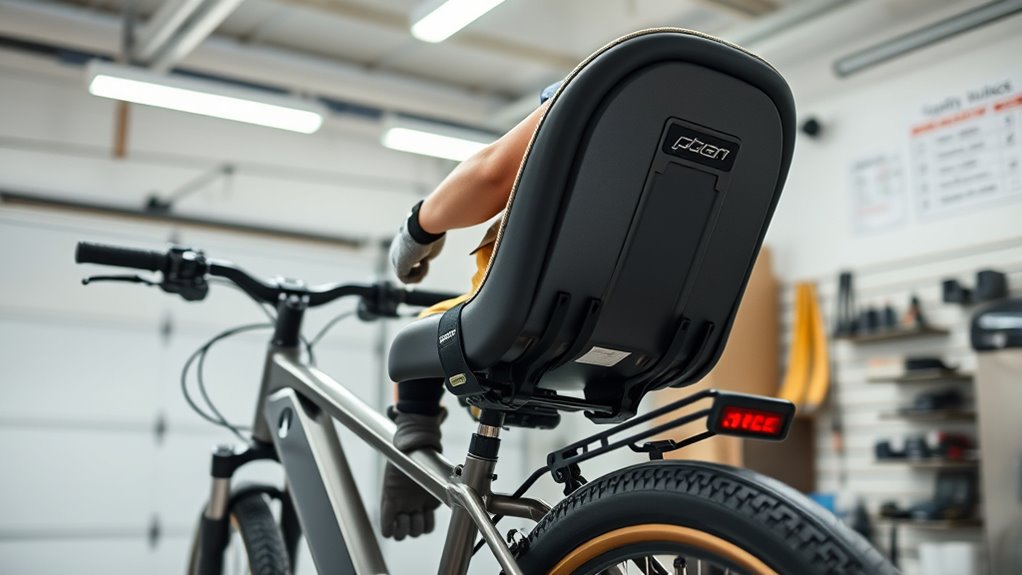
Before each ride, you should perform a stability and security check to guarantee your child seat is firmly mounted and safe. Make certain the seat is tightly attached to your e-bike, with no wobbling or looseness. Check that the child seat materials are intact, free from cracks or damage, especially around straps and mounting points. Confirm the seat’s child seat color options haven’t faded, indicating wear, and verify all harnesses and buckles are secure. Test the stability by gently rocking the seat; it shouldn’t shift. Confirm all mounting hardware is tight and properly aligned. Finally, inspect the overall condition of the seat and its mounting point, ensuring they are safe for your child’s ride. These simple steps help prevent accidents and keep your little one secure. Additionally, inspecting for damage or deterioration can help identify potential hazards before riding.
Tips for Safe Riding With Your Child on Board
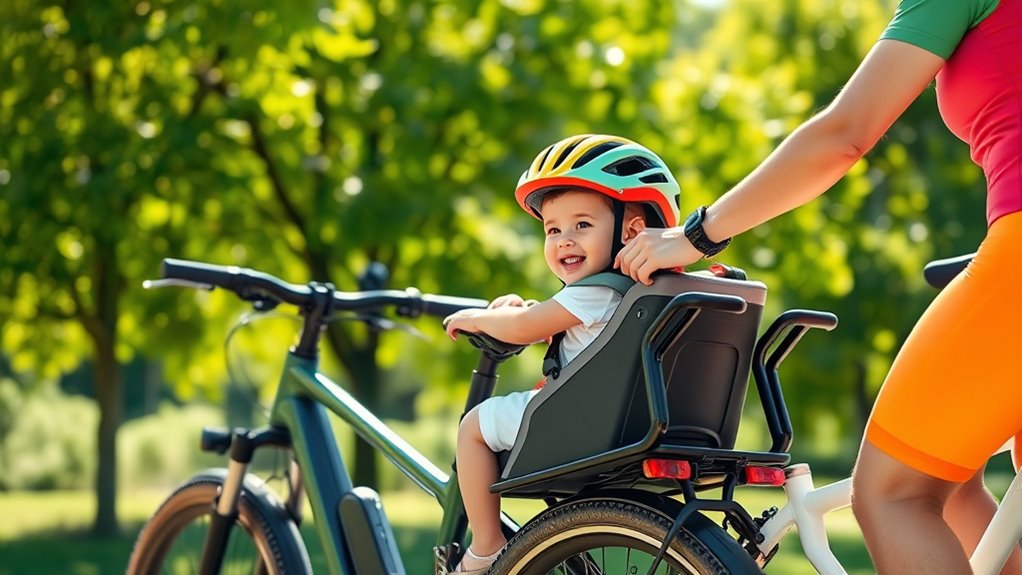
Riding with your child on board requires constant attention to safety. Always guarantee your child’s safety by keeping their helmet properly fitted and secure. Communicate clearly, using hand signals and eye contact to stay aware of your surroundings. Maintain your bike regularly, checking tire pressure, brakes, and the child seat’s secure attachment to prevent accidents. Avoid sudden stops or sharp turns that could unbalance the bike or cause your child to shift unexpectedly. Keep your speed moderate and avoid bumpy or uneven terrain. Be mindful of weather conditions, as wet or windy weather can compromise safety. Regular bike maintenance is essential for smooth handling and quick response. Additionally, understanding how to properly fit a child seat on an e‑bike is crucial for ensuring your child’s safety during every ride. By staying alert and attentive, you create a safe environment for both you and your child during every ride.
Frequently Asked Questions
Can I Install a Child Seat on an Electric Mountain Bike?
You can install a child seat on an electric mountain bike, but first check bike frame compatibility to guarantee it can support the seat securely. Look for a sturdy rear rack or dedicated mounting points. Use proper child seat installation tips, like tightening straps and double-checking stability. Always prioritize safety, and consult your bike manufacturer’s guidelines to confirm your e-bike’s suitability for carrying a child seat safely.
What Weight Limit Should the Child Seat Have?
Think of choosing a child seat as finding the right fit for a puzzle piece. You should always follow the child seat compatibility and weight capacity guidelines to guarantee safety and stability. Most seats are designed for children up to 40 pounds, but always check the manufacturer’s recommendations. Staying within these limits keeps your little rider secure and your ride smooth, preventing any surprises along the way.
Are There Specific Child Seats Recommended for E-Bikes?
When choosing a child seat for your e-bike, you should look for models specifically recommended for e bike accessories. These seats often feature better child seat compatibility with your bike’s frame and power assist system. Always check the manufacturer’s guidelines and guarantee the seat securely attaches to your e-bike. Opt for reputable brands known for safety and durability, making your ride safe and comfortable for your child.
How Do I Ensure the Child’s Safety During Acceleration?
Research shows that proper safety measures greatly reduce risks during bike rides. To guarantee your child’s safety during acceleration, always use a secure child harness that keeps them stable in the seat. Additionally, you should maintain close parental supervision and avoid sudden acceleration or sharp turns. By combining these precautions, you create a safer environment, making your ride enjoyable and secure for your little passenger.
Do I Need Special Insurance for Riding With a Child on an E-Bike?
You might need special insurance when riding with a child on your e-bike, depending on local regulations. Check your insurance requirements to guarantee you’re covered for riding with a passenger, especially a child. Always wear safety gear like a helmet and reflective clothing to protect your little one. Some policies may specify additional coverage for carrying children, so confirm with your provider to stay compliant and safe while enjoying your ride.
Conclusion
Fitting a child seat on your e-bike is like planting a seed—you need the right tools, patience, and care to make sure it grows into a safe, sturdy foundation. Follow these steps carefully, double-check your work, and stay attentive to your child’s comfort. With a solid setup, you’ll be steering through adventures together, confident that your ride is as secure as a well-rooted tree. Happy riding, and cherish every moment on this shared journey!
